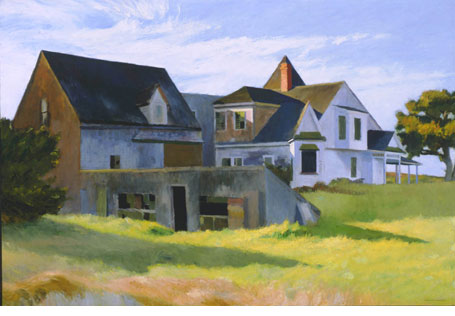 Edward Hopper, Cape Cod Afternoon, 1936,
Oil on canvas, Patrons Art Fund, 38.2,
Edward Hopper, Cape Cod Afternoon, 1936,
Oil on canvas, Patrons Art Fund, 38.2,
1937 Carnegie International.
“Edward Hopper’s work made him one of the most
respected American painters of the 20th century,”
says Richard Armstrong, The Henry J. Heinz II Director of
Carnegie Museum of Art.
While Hopper’s work may not appear avant-garde today,
his paintings appeared in 22 different Carnegie Internationals
between 1924 and 1967. Trained at the New York School of
Art, Hopper was a realist painter whose work recorded the
starkness and vastness of America.
Hopper painted Cape Cod Afternoon in 1936 during
the Great Depression and the beginnings of war in Europe.
Modern in its simplicity, it reflects the Puritan values
of America’s past. The painting appeared in Carnegie
Museum of Art’s 1937 International and was
purchased through the museum’s Patrons Art Fund at
the close of the exhibition. Today, it remains an important
part of the museum’s collection and a visitor favorite.
Hopper’s work is typically distinguished by its simplicity,
clarity, and subtle psychological edge, perhaps a reflection
of the man himself. Described as intensely private, Hopper
made solitude and introspection important themes in his
painting. Cape Cod Afternoon is a perfect example:
This deceptively simple view of a shed, barn, and house
in South Truro, Massachusetts, acts powerfully on viewers’
emotions in conflicting ways.
At first, the bright sunshine, brilliant colors, and idyllic
setting that depict a hot, clear, late afternoon on the
Cape Cod coast evoke a feeling of tranquility and optimism.
Yet, as pointed out by Armstrong, upon further inspection,
the long afternoon shadows, crumbling shed, shuttered windows,
and dry, brown landscape suggest something else. “Perhaps
indicative of the period during which Hopper painted
Cape Cod Afternoon, the austere and isolated house
suggests a spare and lonely existence in a rugged and then-remote
part of America.
"After working at the Whitney Museum of American Art,
which is the repository of Hopper's work, I have a bias
for Hopper,” says Armstrong. “I particularly
enjoy Cape Cod Afternoon because it so persuasively
embodies the late summer light we all recall longingly during
these dark winter days."
Back
| Top |